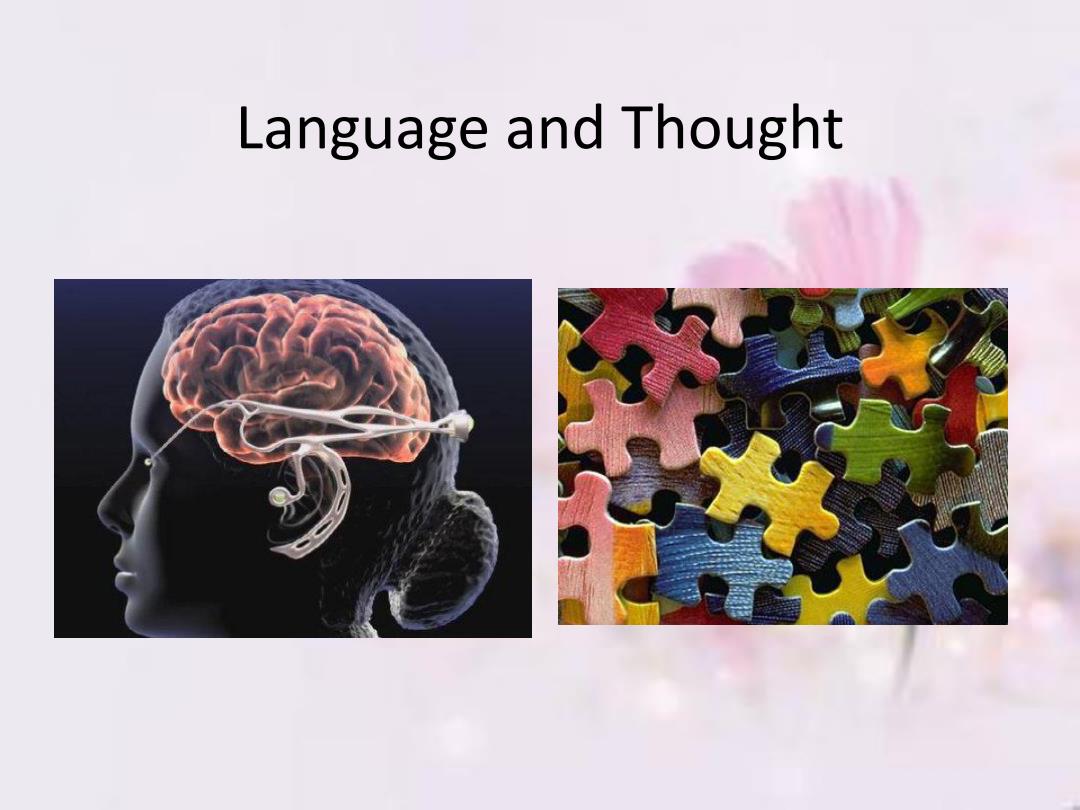
Language and Thought
Language and Thought

Psycholinguistic analysis often relates psychological mechanisms of language use with the human brain. The human brain consists of the right hemisphere and the left hemisphere.The right hemisphere is particularly involved in interpretation of visual- spatial information,perception of nonlinguistic sounds,holistic reasoning,visual and spatial skills, recognition of patterns,and recognition of musical melodies. The left hemisphere is responsible for the processing of new linguistic information and is thus involved in language and speech,analytic reasoning,temporal ordering,reading,writing,calculation,and associative thought
• Psycholinguistic analysis often relates psychological mechanisms of language use with the human brain. • The human brain consists of the right hemisphere and the left hemisphere. The right hemisphere is particularly involved in interpretation of visual- spatial information, perception of nonlinguistic sounds, holistic reasoning, visual and spatial skills, recognition of patterns, and recognition of musical melodies. • The left hemisphere is responsible for the processing of new linguistic information and is thus involved in language and speech, analytic reasoning, temporal ordering, reading, writing, calculation, and associative thought

Language is.... the Jewel in the Crown of Cognition We think only through the medium of words. Language is a constituent part in the thought. .One cannot think anything that lies outside the limits of language
Language is…. • the Jewel in the Crown of Cognition • We think only through the medium of words. Language is a constituent part in the thought. •One cannot think anything that lies outside the limits of language

Thought Thought is a silent inner conversation of the soul with itself. Thinking practically depends on language;the two reciprocally condition each other.-----Karl W.F.Solger
Thought • Thought is a silent inner conversation of the soul with itself. • Thinking practically depends on language; the two reciprocally condition each other.-----Karl W. F. Solger

Traditionally,language is thought to be the dress of thought.A speaker reveals his intention in his own language.Language and thought are mutually dependent to each other
• Traditionally, language is thought to be the dress of thought. A speaker reveals his intention in his own language. Language and thought are mutually dependent to each other

the interactive relationship between language and thinking Language reflects thinking and thinking is shaped by language. Precise thinking leads to clear and precise language; sloppy use of language (vague,general,indistinct, imprecise,foolish,inaccurate)leads to sloppy thinking. Ambiguity in language can lead to misunderstanding. e.g.:Write a short essay on the topic given below in Chinese. Aristotle said logical fallacies arise from the use of ambiguous words and phrases.-----Thinking is ensnared in words
the interactive relationship between language and thinking • Language reflects thinking and thinking is shaped by language. • Precise thinking leads to clear and precise language; sloppy use of language (vague, general, indistinct, imprecise, foolish, inaccurate) leads to sloppy thinking. • Ambiguity in language can lead to misunderstanding. e.g.: Write a short essay on the topic given below in Chinese. Aristotle said logical fallacies arise from the use of ambiguous words and phrases.-----Thinking is ensnared in words

To expand language is to expand the ability to think
• To expand language is to expand the ability to think

language helps us think In Chomsky's (1968:103)word,language serves as an instrument of free thought and expression. The relation between language and thought is also presented in Sapir-Whorf hypothesis, which makes the claim that the structure of the language one habitually uses influences the manner in which one thinks and behaves
• language helps us think • In Chomsky's (1968: 103) word, language serves as an instrument of free thought and expression. • The relation between language and thought is also presented in Sapir-Whorf hypothesis, which makes the claim that the structure of the language one habitually uses influences the manner in which one thinks and behaves